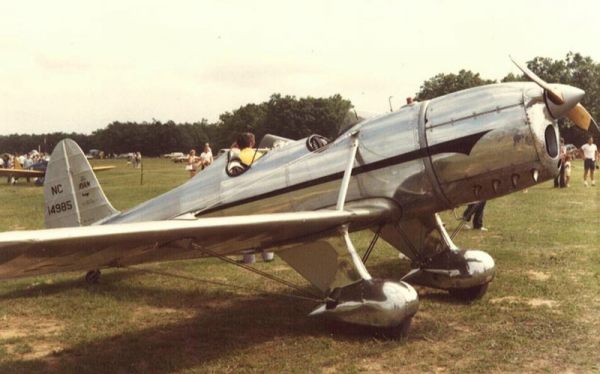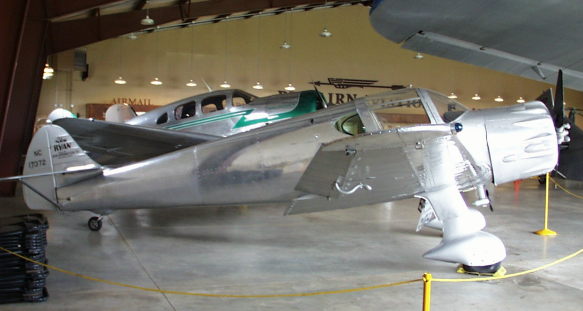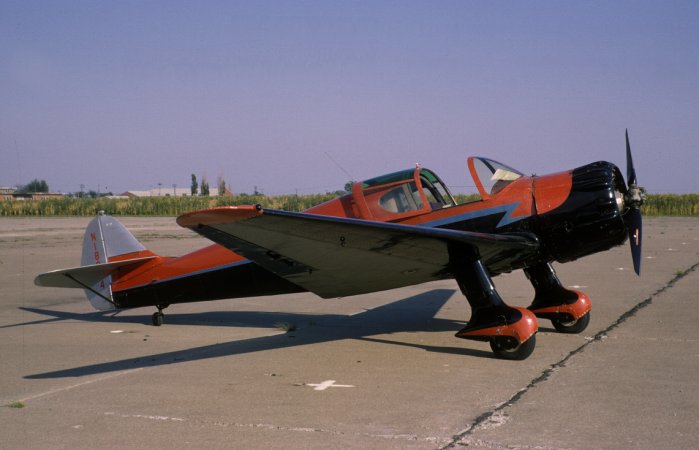The Ryan line began when T. Claude Ryan started building airplanes to complement his flying service. His most famous aircraft is a specially-built long-range variation on the Ryan Brougham, the Spirit of St. Louis, flown by Charles Lindbergh.
Ryan went on to run a flight school, and it was in this role that he again began building aircraft in the mid-30s. The first "New Ryan" was the ST, for Sport Trainer.

The ST is an open cockpit tandem seating two place trainer, built with a Menasco inverted inline engine. The construction was advanced for the day, being a low-wing monoplane with an all-metal monocoque fuselage. The wings on the ST are wire-braced and built with a wood spar. The ST when through several variations and evolved into the PT-22, powered by a Kinner radial, which was ordered by the military as a primary trainer in WWII.
In the late 30's the general aviation market was shifting away from the open-cockpit biplane trainers and towards closed-cabin traveling aircraft with a premium on reliability, speed, and comfort. Ryan recognized this trend and designed a new airplane, the Sport Coupe or SC. The SC built on the design of the ST using the same all-metal monocoque fuselage, but the SC went one step further using an all-metal full cantilevered wing. The SC also had a closed side-by-side cabin for greater versatility and comfort. The original SC prototype was powered by a Menasco.
During the flight testing, the Menasco proved to be less than reliable, so Ryan redesigned the airplane with a Warner 145 horsepower Super Scarab radial engine. This redesign changed the nose profile and added a large cowling, but the rest of the aircraft was unchanged. The resulting aircraft was re-certified as the SC-W. Here's a picture of the original SC-W aircraft at the EAA Pioneer Airport in Oshkosh, Wisconsin.

There were 13 SC's built, of which about 9 survive today. Claude Ryan's vision for the aircraft was to stamp out the metal parts used in the monocoque fuselage and wing. Stampings require a lot of initial tooling, but once the tooling is created it is relatively cheap and easy to turn out hundreds of copies. Unfortunately WWII intruded. Just at SC production was getting going, the Army Air Corp came along and made Ryan an offer he couldn't refuse to run flight schools and equip those schools with the PT-22. Ryan shifted most of his production to the PT-22 and SC production ceased, never to resume.
Most of the surviving examples have been re-equipped with a Warner 165 HP engine. These engines are the same size as the original 145 HP engine, but they're much more usable on a regular basis since the 165 HP engine has pressure lubricated rocker boxes and doesn't need to be manually greased every few hours.
Here's my plane from 1964 - it was painted at that time!

There are at least two examples that have been re-engined with a postwar flat engine.
I believe that my example, N18914, is one of only four being actively flown as of the end of the year 2002. There is another that should be flying again in the spring of 2003. Of the examples on the FAA registry, here is the current status as I hear stories and/or see the aircraft:
| Registration | Location | Comments |
| N17372 | EAA Pioneer Airport, Oshkosh, Wisconsin | The original prototype. Museum quality display but not in airworthy condition. |
| N18900 | Schellville Airport, Sonoma, California | Should be flying again in Spring of 2003. Equipped with a flat engine. This is the last SC built, assembled in the 50's from leftover factory parts. |
| N18908 | Florida | Flying. Has a shortened engine cowling. |
| N18911 | Rumored to be in Carson City, Nevada | Equipped with an E-series Continental flat engine. Rumored to be in restoration at Carson City, Nevada. |
| N18912 | Santa Paula, California | Flying. |
| N18914 | Renton, Washington | Flying. |
| N18915 | North Las Vegas, Nevada | Flying as of December 2002. Equipped with a 185 HP Warner engine and an Aeromatic prop. |
| N46207 | Hollister, CA. | Wrecked in the river at Santa Paula in 1989. Repaired and partially reassembled as of early 2004. |
| N830E | Washington, DC | Under reconstruction in the mid-80s. |
After World War II, Ryan briefly re-entered the general aviation market with the Navion, but that aircraft was not a long-term success. The Ryan Company left the civilian market and produced on some specialized military aircraft such as the Fireball and Vertol, but was most successful in building unmanned target and reconnaissance drones such as the Firebee and Global Hawk.